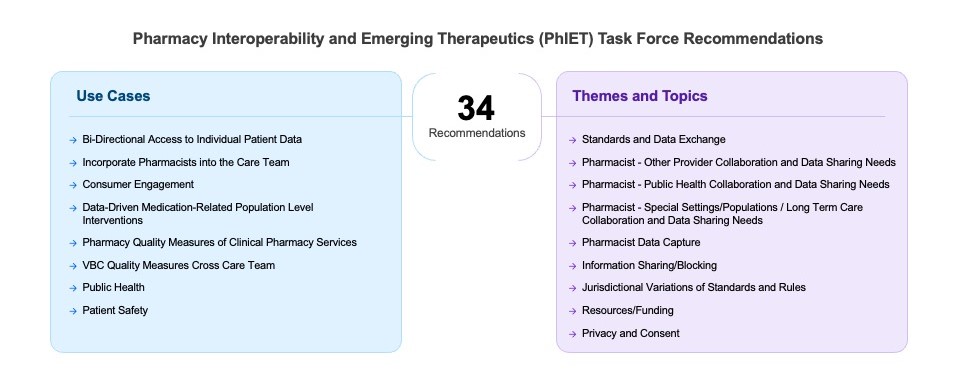A year ago, based on the work led by the Pharmacy Interoperability and Emerging Therapeutics (PhIET) Task Force, the Health Information Technology Advisory Committee (HITAC) made recommendations to support interoperability between pharmacy constituents as well as the exchange of information necessary for medication management, patient safety, and consumer engagement.
As a pharmacist, it was a profound moment for me since this marked the first time the HITAC had focused solely on pharmacy interoperability. In fact, with 25 members spanning clinicians, information technology (IT) developers, government agencies, health care organizations, payers, and patient advocates, it was one of the largest task forces to date! Hats off to co-chairs Hans Buitendijk and Shelly Spiro for their excellent work leading such a large group.

The resulting HITAC-approved PhIET Task Force recommendations spanned numerous themes and use cases (Figure 1) that we know will require industry-wide collaboration. The more routine pharmacy-based and pharmacist-delivered clinical services (e.g., immunization, medication therapy management, genetic testing, state-specific prescribing authorities) become, the more we will need improved coordination between pharmacists, prescribers, and other pharmacy constituents. I’m excited to share an update on work being done by ASTP and industry leaders to further these task force recommendations:
Facilitating Sharing of Key Demographic Data
Demographic data is not consistently available to pharmacy constituents for key use cases such as public health reporting, quality measurement, or social determinants of health (SDOH) interventions. The task force identified race and ethnicity as key demographic data elements that should be captured or available for sharing.
- ASTP’s HTI-2 proposed rule proposes to require that race and ethnicity to be reported in certain e-prescribing transactions using National Council for Prescription Drug Programs (NCPDP) SCRIPT Version 2023011, which includes fields for race and ethnicity data capture.
Promoting Pharmacist Participation in TEFCA™
The Trusted Exchange Framework and Common AgreementTM , also known as TEFCATM , provides a framework to enable nationwide network-to-network health information exchange for participating health care providers, patients, public health agencies, and payers. The PhIET Task Force identified TEFCATM as a way to provide pharmacists the necessary information to coordinate with other providers and inform treatment decisions.
- The Sequoia Project, a non-profit advocate for nationwide health IT interoperability, formed a new Pharmacy Workgroup as part of its flagship Interoperability Matters program, to focus on pharmacy and pharmacist participation in the Trusted Exchange Framework and Common Agreement™ (TEFCA™).
Pharmacy Product Location Functionality
Currently there is no way to inform providers or patients if a prescribed drug is available at a pharmacy location prior to sending a prescription. This lack of transparency can result in treatment delays and an unwelcome burden on providers and patients looking to find a prescription.
The NCPDP WG 11 Pharmacy Product Locator Task Group was formed to explore the business cases and creation of an automated technical solution providing the availability/on-hand status of a pharmacy product on behalf of a patient.
- NCPDP has initiated a pilot to test this functionality and participant recruitment is underway.
Bi-directional Data Exchange and Incorporating Pharmacists into the Care Team
Standards development organizations such as NCPDP and Health Level Seven International® (HL7®) have a long history of developing industry standards for the use and exchange of administrative and clinical data used throughout the healthcare sector. The Pharmacy Health IT Collaborative (PHITC) has developed resources to support standards-based clinical exchange, care coordination and medication management by pharmacists and pharmacy constituents.
- PHITC and NCPDP are working to evaluate and update HL7/NCPDP EHR Pharmacy Profiles
- Continuation of NCPDP and HL7 standards coordination on key pharmacy use cases and needs.
ASTP is grateful for the forward-leaning organizations working on these issues and calling attention to pharmacy interoperability. As exciting as these updates are, we know these areas of progress are just the tip of the iceberg of what’s needed to support interoperable data exchange between all pharmacy constituents involved in managing an individual’s care and medication therapy. The future is bright; we’ll get there quicker together!






